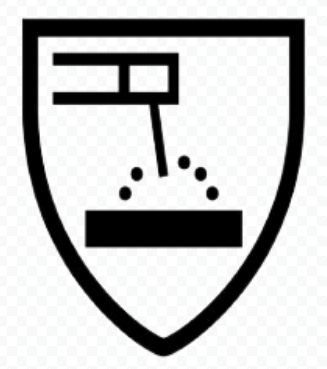Workwear & Uniforms
EN ISO 20471
High visibility clothing
Standard ISO 20471 specifies requirements for high visibility clothing which is capable of visually signalling the user's presence. The high visibility clothing is intended to provide conspicuity of the wearer in any light condition when viewed by operators of vehicles or other mechanized equipment during daylight conditions and under illumination of headlights in the dark.
EN ISO 11611
Protective clothing for welding and alied processes

This standard specifies the safety requirements and test methods for protective clothing worn during welding and alied processes with comparable risks.
EN ISO 11612
Protection against heat and flame
The performance requirements set out in ISO 11612:2015 are applicable to protective clothing which could be worn for a wide range of end uses, where there is a need for clothing with limited flame spread properties and where the user can be exposed to radiant or convective or contact heat or to molten metal splashes.
EN ISO 469
Protective clothing for firefighting
This European standard specifies the minimum required levels for protective clothing that is used during firefighting procedures and associated activities.
EN ISO 14116
Protection against flame
SO 14116:2015 specifies the performance requirements for the limited flame spread properties of all materials, all material assemblies, and protective clothing in order to reduce the possibility of the clothing burning when in occasional and brief contact with small flames and thereby constituting a hazard.
When protection against heat hazards is necessary, in addition to protection against flame, this International Standard is not appropriate. International Standards such as ISO 11612 are to be used instead.
When protection against heat hazards is necessary, in addition to protection against flame, this International Standard is not appropriate. International Standards such as ISO 11612 are to be used instead.
EN 1149-5
Electrostatic properties - Part 5: Material performance and design requirements
Fabrics for garments created for those working with highly combustible materials need anti-static or conductive properties in their garments to prevent static sparks that can lead to combustion or even explosions.
EN 343
Protection against foul weather
This European Standard specifies requirements and test methods applicable to materials and seams of protective clothing against the influence of precipitation (e. g. rain, snowflakes), fog and ground humidity. The testing of rain proofness of ready made garments is excluded in this standard at this time because a separate test method for such a property is currently being prepared.
IEC 61482-2:2009
Protective clothing against the thermal hazards of an electric arc
IEC 61482 specifies requirements and test methods applicable to materials and garments for protective clothing for electrical workers against the thermal hazards of an electric arc.
Marine Safety
UL 1191
Components for Personal Flotation Devices
These requirements cover components intended for use in the manufacturer of personal flotation devices and immersion suits. Compliance with these requirements does not indicate that the product is intended for use as a component of an end product without further investigation. The requirements shall be applied to other components if found to be appropriate.
TSO C13 F
Aviation life jackets
Inflatable Emergency Equipment II: Evaluation of Individual Inflatable Aviation Life Preserver Retention Characteristics
ISO 12402-7
Personal flotation devices. Part 7: Materials and components
This standard specifies the minimum requirements for the construction and performance of materials and components of personal flotation devices, as well as the relevant test methods.
SOLAS
Safety of Life at Sea
The SOLAS Convention in its successive forms is generally regarded as the most important of all international treaties concerning the safety of merchant ships.
The main objective of the SOLAS Convention is to specify minimum standards for the construction, equipment and operation of ships, compatible with their safety.
Click here to see all products that comply with SOLAS
The main objective of the SOLAS Convention is to specify minimum standards for the construction, equipment and operation of ships, compatible with their safety.
Click here to see all products that comply with SOLAS
Toy Safety
EN 71-3
Migration of certain elements
EN 71-3 specifies requirements and test methods for the migration of aluminium, antimony, arsenic, barium, boron, cadmium, Chromium (III), Chromium (VI), cobalt, copper, lead, manganese, mercury, nickel, selenium, strontium, tin, organic tin and zinc from toy materials and from parts of toys.
CPSIA section 108
Prohibition of specified Phthalatesin childrens toys
CPSIA Section 108(a) permanently prohibited the manufacture for sale, offer for sale, distribution in commerce, or importation into the United States of any “children's toy or child care article” that contains concentrations of more than 0.1 percent of di(2-ethylhexyl) phthalate (DEHP), dibutyl phthalate (DBP), or butyl benzyl phthalate (BBP).
Tents & Structures
NF P 92-507
FIRE SAFETY for INTERIOR FITTING MATERIALS
French fire safety standard for interior fitting materials. Classification (M1-M4) according to their reaction to fire.
DIN 4102
Fire behaviour of building materials and elements
This German standard defines fire behavior classes for building materials and specifies requirements and test methods for each class
BS 7837
Flammability performance for textiles used in marquees and similar textile structures
British Standard specifying flammability performance for textiles used in the construction of marquees and similar textile structures
CPAI-84
fire resistance of fabric used in camping tents
CPAI-84 is a testing method used specifically for confirming the flame resistance of fabric used in manufacturing camping tents.
Drinking Water
WRAS
Water Regulations Approval Scheme
The Water Regulations Approval Scheme is an independent UK certification body for plumbing products and materials, helping business and consumers choose compliant products that keep water safe.